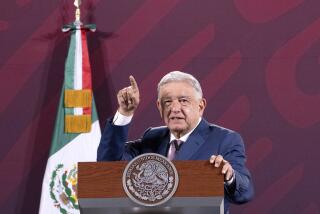U.S. Phone Giants, Telmex Do Battle Over Long-Distance
- Share via
MEXICO CITY — Global competition descended on Mexico’s long-distance telephone market last year like a rude wake-up call, complete with insulting ads, piracy and customer “slamming,” technical foot-dragging and regulatory cat fights.
Now, Year 2 of the long-distance battle has begun with a sharp escalation that has already spread across the border into U.S. territory.
The dispute pits Telefonos de Mexico, the privatized national phone company known as Telmex, against U.S. giants MCI Communications and AT&T; and their local partners. Those and other new consortiums were allowed to compete with Telmex for long-distance service starting in January 1997, and in the first year lured away 27% of Telmex’s customers.
MCI now has launched a cross-border attack against what it calls Mexico’s “discriminatory regulatory regime”--rules that force long-distance companies to give Telmex up to 70% of their billings as payment for routing long-distance calls through Telmex’s network to customers’ homes and offices.
In January, MCI threatened to cancel $900 million in planned additional investment in Mexico unless the rules were changed. And this month MCI asked the U.S. trade representative to challenge Mexico’s fee structure at the World Trade Organization.
More provocatively, MCI and AT&T; have appealed a U.S. Federal Communications Commission ruling in October approving Telmex’s entry into the American long-distance market. MCI and AT&T; say Telmex shouldn’t be allowed to compete in the United States until Mexico reduces the surcharges and cuts its international calling rates.
Despite its loss of market so far, Telmex--once a bloated state monopoly--has surprised analysts with its transformation into a competitive telecommunications heavyweight, and it is counterpunching deftly.
With considerable glee, billionaire Telmex chief Carlos Slim declared last week that while Mexico is opening up to global competition, giants AT&T; and MCI want to shut out foreign competitors from the supposedly open U.S. market.
MCI and AT&T; are “behaving like a young child trying to get attention,” Slim told reporters in Mexico City.
Telmex says it doesn’t understand the outcry against the rate structure, noting that the rules were set publicly back in 1996 and that the competitors understood them when they set up shop. What’s more, Telmex officials say, its fees are standard international practice designed to offset massive investment costs.
The flap intensified last week when the two countries’ top regulatory agencies sniped at each other. FCC Chairman William E. Kennard publicly sided with MCI and AT&T;, calling on Mexico to cut Telmex’s “inflated” fees. Mexico retorted that its fees have already been cut dramatically and are scheduled for further steep cuts.
The long-distance stakes are huge and growing fast: Telmex billed 3.5 billion minutes of international calls in 1996, the latest year for which figures are available, up 16.2% over 1995, thanks to a recovering economy and expanding market. Nearly all of that business was with the U.S.
Telmex hoped by this time to have already launched its U.S. long-distance service, a joint venture with Sprint Communications, aiming to take market share in the U.S. Latino community. But now, as the FCC considers the appeal, the venture is being held hostage to the U.S. firms’ demand for regulatory changes in Mexico.
Slim said that if anyone has a legitimate complaint to put to the World Trade Organization, it is Telmex--on grounds that MCI and AT&T; are blocking entry into the U.S. long-distance market.
Mexico’s richest man added that Telmex’s loss of so many of its long-distance customers in 1997, resulting in a 32% decline in international call revenue, is proof that the Mexican market is wide open despite the competitors’ complaints.
“They thought that our clients would come running to them. They thought they would conquer the whole long-distance market. But they incurred heavy expenses. They resorted to [customer] piracy, to charging rates below cost, and now they are paying a heavy price,” Slim said.
“As long as [the competitors] keep doing dumb things, they will keep losing,” he added.
Analysts see elements of posturing by the Americans in the hardball negotiating tactics.
“MCI and the other operators who entered the long-distance market knew what the rules were. Yet the noise has become deafening only very recently,” said Lars Schonander, head of research for Santander Investments in Mexico City. “The reason is that it hasn’t gone as well as expected, partly because Telmex has maintained market share more than most observers expected.”
MCI is a partner in Avantel, the most aggressive long-distance consortium in Mexico. In the first year of competition, Avantel grabbed 12% of the $4-billion-a-year market. With less fanfare, the other major consortium, AT&T-backed; Alestra, took nearly 15% of Telmex’s long-distance market share.
But in a sign of the market’s confidence in the changes imposed on Telmex by controlling shareholder Grupo Carso and its boss, Slim, Telmex shares--which account for more than 20% of the market capitalization of the Mexican stock exchange--soared nearly 70% in 1997 and outpaced the overall market.
Since Telmex was privatized in 1990, Slim has invested more than $13 billion to upgrade and extend service and cut the waiting time for a new line from years to days. An additional $1.2 billion is to be invested this year in new exchanges and the extension of a fiber-optic network that stretches more than 20,000 miles. Callers no longer have to wait a minute or two for a dial tone.
The core of the current dispute is that the Mexican Federal Telecommunications Commission allows Telmex to charge the long-distance firms 58% of the revenue earned on every incoming international call, plus an “interconnection fee” for putting the call through Telmex’s network to the customer.
MCI Chief Executive Gerald H. Taylor complained that the connection charge and other access fees mean Telmex gets about 70% of the money billed by its competitors for incoming international calls.
“The system of subsidies created by the Mexican authorities in 1996, ostensibly to ensure Telmex’s ability to provide universal service, has generated far more revenue for Telmex than the Mexican government ever imagined,” Taylor said in a letter to FCC chief Kennard.
MCI and AT&T; also object to delays in reducing Mexico’s high basic rate charged for incoming international calls, now 37.5 cents per minute, on average. This is scheduled to decrease gradually over the next two years, then drop sharply in 2000 to 19 cents.
Because Mexico receives 2.6 times as many international calls as it places, the revenue from incoming calls is huge, earning Telmex $850 million in fees in 1996.
Telmex responds that it’s standard practice worldwide to charge competitors to connect to a costly national network--especially since the income will help finance expansion of a phone system where there are still only about 10 phones per 100 inhabitants, compared with 50 per 100 in the United States. The more lines there are, Telmex says, the more long-distance customers there will be for it and its competitors to serve.
Competition was introduced in 60 cities last year and will reach 40 more this year.
Mexican consumers certainly benefited from the onset of competition, as domestic long-distance calling rates fell more than 25%. International calling costs also fell, by varying degrees.
But the competition also brought confusion, duplicate bills and customer piracy, or “slamming.”
In December, Mexican regulatory authorities imposed more than $1 million in fines against Telmex, Avantel and Alestra for a range of long-distance offenses. More than 300,000 customers complained that they were being billed for services they hadn’t signed up for. Telmex was also fined for delays in connecting more than 200,000 customers who chose other services.
If that sounds familiar, it’s because similar complaints were made against AT&T; during phone deregulation in the United States in the 1980s--by MCI, among others.
Mexicans were sent ballots last year to choose their long-distance provider. Those who didn’t vote stayed with Telmex by default. Analysts were surprised that despite the legacy of atrocious phone service in the 1980s, most customers didn’t bother to vote--and most who did stayed with Telmex.
Telmex has successfully--if disingenuously--promoted its Mexican-ness. The company’s advertising has blatantly appealed to Mexicans’ nationalistic sentiment, even though its U.S. competitors have majority Mexican investors, including the country’s largest bank, Banamex, and the Alfa industrial group.
One Telmex ad shows a gringo fat cat, “Mr. Helms Burton,” practicing golf in his office and musing in bad Spanish how he’ll exploit Mexican customers--a play on the much-resented U.S. Helms-Burton Act limiting trade with Cuba.
Conspicuously absent from the ads are any mention of Telmex’s own minority privatization partners: Southwestern Bell of St. Louis and France Telecom.
(BEGIN TEXT OF INFOBOX / INFOGRAPHIC)
Tough Call
Since competition was introduced to Mexico’s long-distance telephone market in January 1997, former monopoly Telmex has seen its share drop by more than 25%. But it has been a tougher competitor than expected. 1997 share in the 60 competitive cities, based on numbers of phone lines:
Telmex (includes foreign partners): 73%
Alestra (U.S. partner is AT&T;): 14%
Avantel (U.S. partner is MCI): 12%
Others*: 1%
* Iusatel, Marcatel, Miditel and Protel
*
Source: Federal Telecommunications Commission of Mexico
More to Read
Inside the business of entertainment
The Wide Shot brings you news, analysis and insights on everything from streaming wars to production — and what it all means for the future.
You may occasionally receive promotional content from the Los Angeles Times.










